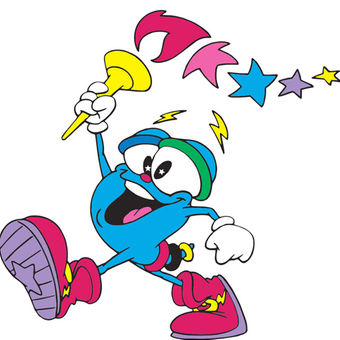What is it? If you have to ask… maybe you should try again

This summer marks the 20th anniversary of the 1996 Summer Olympics in Atlanta. And along with milestone anniversaries come opportunities to reflect on the memories, good and bad, that come from hosting such a significant event.
July’s edition of Atlanta Magazine features one such analysis, Max Blau’s “What is it? An oral history of Izzy, the mascot marketing snafu of Olympic proportions.” It’s an entertaining first-person account about how the Games’ much maligned mascot came to be – and be ridiculed.
The piece is filled with candid takes from key decision-makers and others who had front row seats. You’ll laugh one minute (“I just felt at a loss to exactly what we’re seeing. Like, this is it? This?”) and shake your head the next (“You didn’t question Billy… Who am I to question his choice?”) Hindsight, especially through Izzy’s enormous eyeballs, is 20/20.
Should we leave poor Izzy in the rearview mirror, cast away to the Island of Misfit Mascots? After all, you can’t please everyone all of the time. But the retelling of the Atlanta mascot saga and the process that created it provides some insights and potential lessons on how we should approach branding and the way we present our stories.
- Deadlines matter, and a rushed product may not meet your expectations. As the article recounts, it was a shock when Atlanta – the ultimate longshot – was awarded the ’96 Games in September 1990. A mascot wasn’t exactly at the top of anyone’s to-do list, but Billy Payne, president and CEO of the Atlanta Committee for the Olympic Games (ACOG) who led the campaign to make Atlanta the host city, appointed a group to lead the mascot effort.An immovable deadline already was in place – the new mascot had to make its debut at the closing ceremonies in Barcelona, Aug. 9, 1992. The article is thin on when artist submissions were due (they received just 10 designs they didn’t pay for), but it does mention final designs were due in March 1992 and they were rushing to submit them.
So while certainly there were more important things to do in the year-and-a-half between the announcement and when mascot designs had to be submitted, perhaps some earlier initial design deadlines would’ve allowed for additional feedback and revisions if the first set weren’t deemed up to snuff.
- Don’t go it alone. Seek diverse opinions.There was a mascot committee, but the story makes it clear that the decision was left to one person, Payne, and no one on his committee was inclined to challenge or question his decision at the time. Harry Shuman, who was the public information officer for the Atlanta games, recalls getting “Hi-Rez” (the artist’s name for the original drawing) on a Friday and said Payne made the decision on Monday while Shuman was out of the office. Another key player, Ginger Watkins, ACOG chief of staff in charge of the mascot committee, remembers all the proposals laid out on a large table and Payne making his pick. “It was a gut decision,” she said.
Big projects need successful leaders like Payne, but other voices can add tremendous value, especially when the task at hand is as large as planning an Olympic Games. Marketing and design experts could’ve provided valuable direction and recommendations on the mascot, leaving the CEO to more strategic and pressing matters. In this case, it doesn’t sound like anyone spoke up with their concerns. Then again, perhaps they wouldn’t have been heard?
- History holds valuable lessons.There is something to be said for being different, but when you have history to draw from – especially more than a dozen past mascots as references – there may be insights or trends you can take away. The Olympics official website contains a section on mascots and politely describes Izzy’s uniqueness: “Izzy is an unusual mascot in that he is not an animal, nor a human figure, nor an object.” In fact, no one really knew what Izzy was, which led to the mascot’s original name, “Whatizit.”
Past mascots included native animals, objects or characters that said something about the host city or country. Izzy was a complete departure, and it didn’t help paint Atlanta – still unfamiliar to many internationally – in the best light. “Atlanta had been searching for an identity,” recalled an AJC reporter. Something named Whatizit didn’t help.
- Look for opportunities.The immediate negative reaction to Whatizit’s unveiling in 1992 compelled ACOG to tweak the design and the name. They focused in on the mascot’s potential appeal to kids, letting school children choose the name. Izzy was given a nose and happier disposition. They were proved right – children loved it. And Izzy was a merchandising success. (I was 12 in 1993 and remember getting an Izzy T-shirt during a summertime trip to Atlanta. I’m sure my sister or I also had a stuffed Izzy toy at some point.)
Izzy may not have exactly been lemonade to Whatizit’s lemons, but in the end the taste wasn’t totally sour.
Written by Erin Williamson, Creative Strategist.
Back